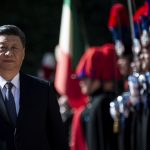Let the Lesser State Know
The midnight attack on terror camps in PoK alone won’t bring Pakistan to heel. We have a lot more to do
 Bharat Karnad
Bharat Karnad
 Bharat Karnad
|
29 Sep, 2016
Bharat Karnad
|
29 Sep, 2016
/wp-content/uploads/2016/09/Lesserstate1.jpg)
A WEEK AFTER the terrorist attack on the Uri Brigade encampments by four jihadi-terrorists that killed 18 troops and wounded some fifty others of the Bihar and Dogra Regiments, and the spiralling of public expectations about imminent and singular retaliation, Prime Minister Narendra Modi at the Bharatiya Janata Party conclave in Kozhikode on 24 September called, anti-climactically, for “a thousand year war” with Pakistan on poverty, disease and illiteracy (albeit, in a thundering tone), sounding verily like a pumped-up political Mother Teresa—all sinew, grace and forgiveness. Not exactly the dislocating measure the BJP General Secretary Ram Madhav had promised when he signalled a “Pakistani jaw” for an Indian “tooth”.
Modi recognised that when the policy cupboard is bare of options, it is best to do nothing, and in this, emulate Atal Bihari Vajpayee (after the 13 December 2001 attack on Parliament) and Manmohan Singh (post-26 November 2008 strike on Mumbai). So he has reacted as a leader of a ‘responsible’ nation with excessive restraint—the hallmark of Indian policy, launched a diplomatic campaign to ‘isolate’ Pakistan, and otherwise red-flagged India’s impotence. The fact that the Prime Minister has been brought this to pass owes centrally to the Indian military’s characteristic laxity and complacency that allowed the terrorist penetration and precipitated the crisis in the first place, bringing the perennial problems of unpreparedness and incapacity to mount a hard- hitting counter once again into the public eye.
Also, evident was the not-so-subtle pressure from the United States, the country’s preferred ‘strategic partner’ in the new century, to be reasonable in dealing with Pakistan-sponsored terrorism, which it does not tolerate itself. Recall the September 2001 visit by the US Deputy Secretary of Defense Richard Armitage to Islamabad in the wake of the 9/11 outrage when he warned General Pervez Musharraf to support the war America was going to unleash on the Taliban in Afghanistan, failing which, to face a Pakistan bombed back to the ‘stone age’. Musharraf duly complied.
But to be fair to previous prime ministers, they decided on doing nothing only after finding out from the Indian military that it could do nothing. Even as the terrorist intruders were being mopped up on Parliament grounds, an emergency meeting was called by Vajpayee to explore retaliation. In his inimitable way, he asked the then Army chief and Chairman, Chiefs of Staff Committee, General Sundararajan Padmanabhan: “Aap kuchh kar sakte hain? (Can you do something?)” There was studied silence accompanied by a slow shaking of his head from side-to-side by Padmanabhan. I have often wondered how this response was ‘minuted’ by the Cabinet Secretary. Seven years later, with Kasab and Company storming five-star hotels on the Mumbai shoreline, the Indian military was, as on the earlier occasion, all at sea. Manmohan Singh questioned the Air Chief Marshal Fali H Major about launching sorties against the Pakistan army-run Lashkar-e-Toiba and Jaish-e-Mohammad training camps and logistics hubs in Pakistan-occupied-Kashmir (PoK), only to be told that the Indian Air-Force did not—just then— have the target coordinates for surgical strikes.
Eight years on, come the attacks on the Pathankot air base this January, and several months later, the attack on the Uri camp, we see the same actors reprising their familiar roles. The Government seemed surprised and acted flustered, the armed services revealed their by-now-patent incapacity to prevent jihadis from sauntering into the Uri camp and shooting Indian soldiers or to retaliate meaningfully. And Modi talked soberly of mobilising international public opinion to pressure Islamabad. India, however, has yet to come to grips with Pakistan’s ongoing asymmetric warfare. With small-scale conflicts seen as diverting it from preparing for ‘proper’ wars, preferably only with Pakistan and then with imported armaments, and resource scarcity hindering the procurement of exorbitantly-priced foreign hardware to fight this war with, the Indian military finds itself unable to prosecute any type of war well, whether it is asymmetric-covert, conventional, or ‘hybrid’ with nuclear overtones.
Moreover, because the Government does not believe in integrating the military or its efforts, there is no centralised authority such as chief of defence staff, nor a single comprehensive operational plan, leaving the three armed services free to tackle terrorism in their separate, lackadaisical, ways. Thus, Army units, time and again, do basic things wrong, like not establishing an impermeable perimeter security to protect their own camps for a start, and the Air Force is always operationally unready, at the point of decision, to launch instantaneous retaliatory raids (even as retired IAF grandees write op-eds extolling aerial strikes as the best means of punitive action against Pakistan).
Post-Uri, one thing is clear: it is Pakistan that is focused, has proved itself adept at conducting a low cost covert war that, to use a tired phrase, ‘bleeds India by a thousand cuts’, and that India has no counter. And it pre-empts Indian retaliation by putting frontline Army divisions on alert, closes off the air space in northern Pakistan and PoK for exclusive military use, sequesters long sections of the Lahore-Islamabad super highway for emergency combat aircraft operations and, aware that New Delhi is easily rattled by nuclear threats, openly flaunts the possibility of using its short-range nuclear missiles in case India sends its armour trundling across the border. In fact, the situation is so unbalanced and favouring the lesser state, Pakistan enjoys both the psychological and seemingly also the material edge. Whence, the spectacle of politicians and ex-soldiers on Pakistan TV programmes jeering at the Indian military’s risk-averse attitude and taunting Indian soldiers for “fearing death”.
The Indian Government, as always, is as confused as the Indian military about how to handle Pakistan’s relentless needling and equally uncertain about how to react. There is apparently no understanding of the nature of the conflict Pakistan has imposed on India. The evidence of this is in the usual harrumphing from official quarters about retribution being visited on Pakistan at a time and place of New Delhi’s choosing. Or, in the ideas mooted by retired military brass, such as former Army Chief General Bikram Singh, who has damned “our traditional laissez faire policy of inaction and passivity”, called for a “befitting response”, and recommended that an appropriate retaliatory scheme be chosen from among a number of “comprehensive plans for all possible contingencies” he claims the military has drafted. But, he calls for the punitive military action to take place only after the “precautionary defensive measures” adopted by the Pakistan military to thwart Indian retaliation are removed. In other words, he advises waiting out the Pakistanis!
It was a typical cross-LoC Indian Special Forces operation to take out a couple of terrorist camps that was staged by the Army on the night of 28 September. It killed some 38 jihadis but did not address the core concern of a capability void
Considering that the Pakistan military is more organisationally nimble and in a higher state of readiness and can be fielded faster than its Indian counterpart, this is useless counsel and, in any case, misses the point. Unless retaliation for terrorist acts is immediate and automatic, it loses its value. The standard operating procedure (SOP) should be that such actions are launched on first information of a terrorist strike followed by an official statement declaring that this action is limited and strictly in response to the preceding terrorist provocation, and that any military riposte to it would be escalatory for which Pakistan would bear the burden. This would offer justification, be a warning, and inhibit Pakistan from taking steps that could lead to spiralling of conflict. Such a clearly articulated Indian policy will be acceptable to the international community as well. However, if India waits for the mythical ‘right time’ to react, it may be a long wait, and the advantage of hitting back instantly would evaporate because, in the intervening time, the causality link between the terrorist incident and the retaliatory action will be lost.
It is precisely the absence of ready capability for a reflexive response, predicated on—and this is important—strike platforms at the ready and geared for instantaneous action and clued by continually updated operational plans and information regarding prioritised target sets and target coordinates, that is at the heart of India’s troubles and, visibly, Pakistan’s success. Such a system of instant and certain retribution kicking in automatically and every time there’s a terrorist provocation would at once establish the norm. Is such a system hard to obtain? Not at all, but curiously nobody in the Indian Government and military has thought of setting it up. So, each terrorist event is a revelation, treated de novo, requires the same bureaucratic head-banging to conceive and plan options, all of which take time. Soon it becomes yesterday’s concern, with the whole process petering out due to the flagging concern of all the parties involved, until the next terrorist event when this rigmarole is repeated.
Most of these terrorist moves would be ‘throttled in the cradle’ as it were if the intelligence agencies and the armed services did their jobs. The 26/11 attack happened in Mumbai because of loose maritime security; Pathankot occurred owing to base security being reduced to a joke, and now Uri because there was no policing of the approaches to the camp. In each case, it is the lack of perimeter security that facilitated the terrorist mayhem.
Let’s consider the Uri episode in slight detail. Uri is a salient, bordered on its three sides by the Line of Control (LoC)—some 6 km at the shortest distance, which is preferred by jihadis for infiltration purposes, and around 14 km in the other two directions. The 27 km of front in this sector is manned by a single Indian Army battalion with two Border Security Force (BSF) battalions in support. The Army and BSF camps are supposedly in adjoining locations. But the institutional tension between the Army and the paramilitary and their desire to minimise interaction led to a virtual ‘no man’s land’ being created between the Army and BSF camps. It is this vacant, unpoliced seam stretching to the LoC that the four terrorists exploited on 18 September to reach the Mess serving the Dogra and Bihari troops. It is the same seam two other jihadis used a few days after the Uri attack, but were apprehended because this time there was proper patrolling. There is, however, no explanation why, despite the awareness of the vulnerabilities of the Uri camp sites, the Army and BSF unit commanders failed to take the elementary precaution of providing overlapping coverage, why no armed watch was mounted in this space, and why the outer tier had no monitoring with raised sand-bagged positions, prefab posts, and roving patrols 24/7, given that Jammu and Kashmir, and especially the areas along the LoC, constitute an active (covert) war zone.
A former Kashmir-based Corps commander blames the Army’s flawed practice of concentrating the technical means for detecting irregular movements such as thermal imagers, on the LoC rather than deploying some of them rearwards to protect military facilities and installations. There’s also the fact that a good proportion of these imagers are, at any given moment in time, offline because they are broken down or undergoing servicing and repairs. Further, as a recent official report has observed, advanced technology surveillance sensors, like thermal imagers and ‘laser walls’ installed on the LoC to spot violations on the border in real time, do not always work as advertised, owing to the difficult terrain. In other words, for fail-proof physical security against terrorists, there’s no alternative to alert manpower, perimeter policing, and attentive patrolling on land and water. But such security regimen will work only when unit commanders are held accountable for lapses rather than, as happened in Pathankot, where the commander of the air base was merely transferred, not cashiered. But imaginative moves to fight terrorists, such as the placement in the mid-1990s of a unit of the powerful Marine Commando on the Wular Lake by the Navy Chief Admiral Vishnu Bhagwat that deterred jihadis from crossing this water body to reach the Srinagar Valley, are missing.
A good solution to sharpen the military instincts and lift spirits may be to empower and incentivise (with proper career-furthering rewards) the commanders of forward deployed units to react to terrorist bedlam by planning and executing reciprocal actions across the LoC with deliberate speed and lethality. This works. On 28 July 2011, in response to Pakistani troops sneaking into a prefab LoC post in the 15 Corps sector and beheading two Indian jawans, a revenge operation was planned, timed for the Eid holidays. Aware that large numbers of Pakistani army officers and men go on leave on this festive occasion, a 20-strong team of five officers, several JCOs, and a bunch of jawans, crossed the LoC and ambushed a truck carrying these Pakistani military-men to their homes. Five enemy heads were taken as trophy. It created a hubbub on the Pakistani side with the Pakistan DGMO (Director General Military Operations) calling his Indian opposite number to complain but meeting with a denial because the Indian DGMO was not in the loop. The message, however, struck home. Pakistanis have not repeated such an atrocity since.
Even though effective, this is still success only at the tactical level. For more enduring impact a two-pronged strategy needs to be pursued. One prong is to put the country’s Special Forces (SF)—which are penny-packeted as Northern Army reserve and wasted in small time missions across the LoC to blow up a bridge here, a culvert there—to more strategic uses deep inside PoK (to hinder progress on the China-Pakistan Economic Corridor, for instance). Indeed, it was a typical shallow (2 km) cross-LoC Indian SF operation to take out a couple of terrorist camps that was staged by the Army on the night of 28 September, perhaps as a face-saving gesture. It killed some 38 jihadis but did not address the core concern of a capability void.
26/11 occured because of loose maritime security, Pathankot due to base security being reduced to a joke, and Uri because there was no policing of the approaches to the camp. In each case, lack of perimeter security facilitated terrorist mayhem
For telling effect, SF actions need to be integrated with RAW’s activities inside Pakistan, as part of a sustained covert war or kuttayuddha . In fact, I have long maintained that as shared legatees of Chanakya’s philosophy and the Arthashastra, it is ironic that Pakistan is a better practitioner of kuttayuddha than India. The other prong is full-court diplomatic pressure in regional and international forums. This two-pronged strategy is premised on the belief that (1) responding to terrorism by ordering field armies into action (as happened with Operation Parakram in 2001) is inapt and a wasteful use of the military, and is to be avoided at all cost, and (2) no matter what, Pakistan will persist with its policy of waging asymmetric warfare against India, the best antidote to which may be to pay Islamabad back in the same coin.
Fortunately, there’s no dearth of faultlines to exploit— Balochistan and Gilgit-Baltistan in PoK being the most obvious, the discontented Muhajir community, Sindhi nationalism, and support for Kabul’s territorial claims by de-recognising the Durand Line as the Pakistan-Afghanistan border, being the other possibilities. The CPEC is an obvious economic target also strategically to discomfit China. Reviving the disbanded CITX (Counter Intelligence Team-X) inside the external intelligence agency, RAW, to more effectively use the resources cultivated within Pakistan, fits in with such strategy. The above covert strategy should hereafter remain the constant in India-Pakistan relations, its talons partially drawn in during periods when Islamabad moderates its policies.
The fact is, diplomatic and other responses hove into view this time around once it became plain the BJP Government had no credible military response-options. But attempts to isolate Pakistan, or to declare it as a state sponsoring terrorism aren’t working because it is not in the US’s and China’s interests to do so. That has left New Delhi scraping the barrel. Ditching SAARC and replacing it with a SAARC-minus Pakistan organisation has some merit. But it will signal a move away from South Asian solidarity. The ramifications of this move will be felt in the long term as China will increasingly dominate Pakistan’s space, which, strategically speaking, will end up hurting Indian interests by consolidating the Chinese presence more fully on this country’s western flank as well. Modi should have thought of what this will end up meaning for India.
The Indus is Pakistan’s lifeline, and any perceived loss of this water may render Islamabad more amenable than any threat from ‘Cold Start’, intervention in Balochistan, loss of SAARC, or rattling of nuclear sabres
Withdrawal of the ‘Most Favoured Nation’ status likewise is a gesture that may cost India more. India enjoys a balance of payments edge in the minuscule bilateral trade of some $3 billion plus with Pakistan. But it will lose twice as much with the loss of the so-called ‘switch trade’ involving all manner of goods from tyres to cosmetics that happens with ships bound for Dubai anchoring off Karachi and offloading some of their cargo.
The other punitive measure being contemplated is not to abrogate the 1960 Indus Water Treaty (IWT), which Washington will not countenance, but to implement its provisions that permit India to more fully harvest the river system, westwards, something Pakistan has feared will reduce the water flow available to it.
The IWT allows India to use 1.34 million acre-feet (MAF) of the Indus waters for irrigation purposes, of which only some 0.792 MAF are presently utilised. India is also permitted to build hydropower projects and ‘run of the river’ storage facilities for 3.6 MAF on the Chenab River, whose main waters are otherwise for exclusive Pakistani use. Further, India has so far not majorly exploited the waters of the three eastern rivers IWT allotted to India (Ravi, Beas and Sutlej) for agriculture, and as much as 3 MAF of water flows into Pakistan and, absent infrastructure there, is completely wasted as a run-off to the sea. Should India, operating within the ambit of the IWT, speed the construction of the requisite infrastructure—big dams, smaller storage facilities, and hydropower stations on the Chenab, and on the eastern rivers, to meet India’s burgeoning energy and water needs—it will psychologically subdue Pakistan. The Indus is Pakistan’s lifeline, and any perceived loss of this water may render Islamabad more amenable than any threat from ‘Cold Start’, intervention in Balochistan, loss of SAARC, or rattling of nuclear sabres.

/wp-content/uploads/2025/01/Cover_Kumbh.jpg)













More Columns
The 90 Hour Work Week Equation Madhavankutty Pillai
The Arctic Great Game Sudeep Paul
Why PM Modi picked Nikhil Kamath for his podcast debut V Shoba